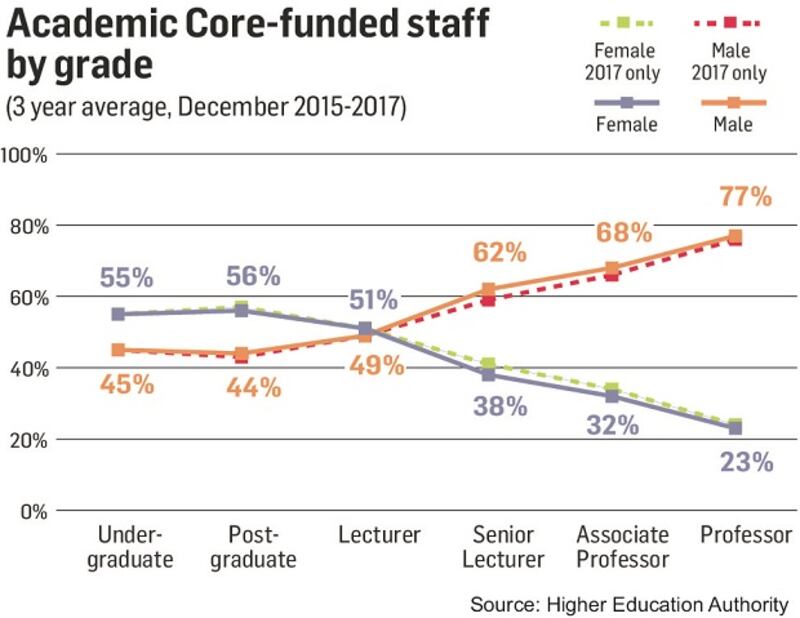The latest figures on gender progression among academics from the Higher Education Authority show some improvement in what has been an intractable problem, but illustrate the extent of the hill still to be climbed.
The HEA figures show that among “core funded” academic staff the proportion of female professors has increased from 23 to 24 per cent since 2015 while the number of female associate professors has increased from 32 per cent to 34 per cent.
The number of senior lecturers has risen from 38 per cent to 41 percent, while the proportion of lecturers who are women is unchanged at 51 per cent. Full and real gender equality remains a distant target.
This is despite an intense focus on the issue in recent years, including a report on gender equality in 2016 by former minister and European commissioner Máire Geoghegan-Quinn.

Among its recommendations was that Irish institutions should adopt the Athena Swan Charter which recognises and celebrates good practice in this area amongst British third-level institutions.
There is an increased commitment in universities, while at Government level a task group established by Minister of State for Higher Education Mary Mitchell-O’Connor is due to report shortly.
Progress is, however, like pulling teeth and with some evidence of a latent desire to keep rotting teeth in place.
The recent decision by UCD to flatly reject a ruling of the Workplace Relations Commission on age discrimination against a female academic of long-standing is an example.
Gender discrimination
The problem is that a culture of gender discrimination is deeply rooted in our entire society and economy.
The Government is committed to addressing it. Last January, Minister for Finance and Public Reform Paschal Donohoe set “a target of 50/50 gender balance in appointments at senior levels” in the Civil Service and the Department of Public Expenditure and Reform “will review the effectiveness of the measures on a regular basis to ensure that they are having an impact over time”.
The National Strategy for Women and Girls 2017- 2020 is also ambitious. It is, however, driven by a largely aspirational language, to "encourage female involvement" "supporting a greater focus on women's participation" and on "accelerating progress".
On equal pay it commits without teeth to “Initiate dialogue between union and employer stakeholders” and “promote wage transparency by requiring companies of 50 or more employees to complete a wage survey periodically and report the result”.
Deeply entrenched attitudes on women’s “place” will only succeed when confronted far more robustly.
Iceland is rated perhaps the world’s most gender neutral country. Nearly half its MPs and company directors are women. First-class daycare and parental leave help ensure almost four in five women have a job.Yet despite an equal pay Act dating to 1961, Icelandic women still earn, on average, between 14 and 20 per cent less than men.
Equal pay
In response Iceland this year became the first country in the world to monitor and enforce equal pay. Within four years from January 2018, any public or private body in Iceland employing more than 25 people not independently certified as paying equal wages will face daily fines. Those with more than 250 staff must comply by the end of this year.
In France gender parity in politics became law in 2000, but political parties found ways to dodge it. President Emmanuel Macron gave it priority and in the last election half his party’s candidates were women. The number of women MPs jumped to 38 per cent , an increase of almost a third in one election.
Last June, New Zealand’s prime minister, Jacinda Ardern, became a first-time mother and insisted on her right to six weeks’ maternity leave, one-third the legal allowance. It is only by such robust approaches that ingrained gender bias will be overcome.Last year the ministry for women in New Zealand released research on the continuing gender pay gap, which reduced steadily since 1998 but stalled for the past decade.
It concluded that differences in education, occupations that men and women work in or the fact that women are more likely to work part-time, only explain about 20 per cent of the remaining pay gap.
The other 80 per cent is driven by “unexplained” factors, like conscious and unconscious bias – “impacting negatively on women’s recruitment and pay advancement”.
Such deep-seated bias and discrimination may seem intractable. But determined government action can deliver real change.
Joan Donegan is general secretary of the Irish Federation of University Teachers










